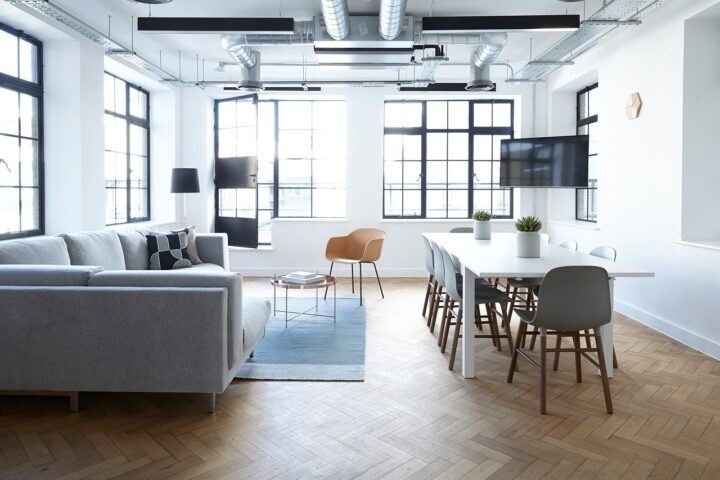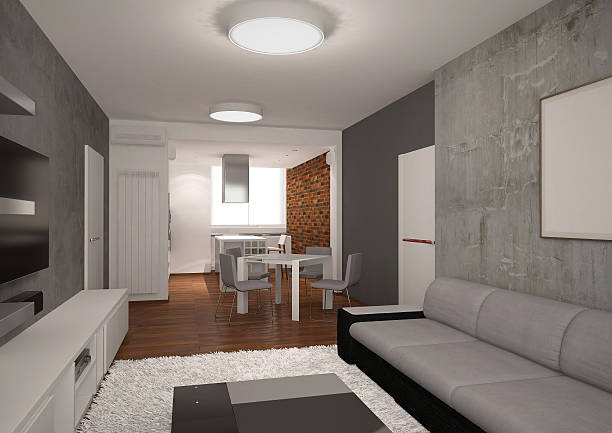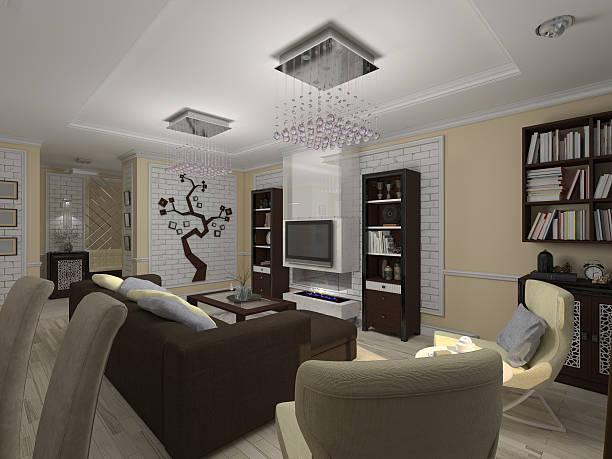Table of Contents
How to Make a Low Ceiling Seem Higher: Simple Tricks for Any Room
Feeling cramped by your low ceiling? You’re not alone, and luckily, there are some easy tricks to make your space feel taller. Using floor-to-ceiling curtains can instantly give the illusion of height. Hang your curtains right at the top of the wall to draw the eye upward.
Another simple fix is paint. Apply high-gloss paint on your ceiling. It reflects light, making the ceiling seem higher. Lastly, adding vertical stripes to your walls can make them appear longer. Just like a striped shirt, vertical lines make things look taller.
Key Takeaways
- Floor-to-ceiling curtains make ceilings look higher.
- High-gloss ceiling paint reflects light to create height.
- Vertical stripes elongate walls and add visual height.
The Basics of Room Design
Designing a room with low ceilings can be tricky, but focusing on the right elements can make it feel more spacious and inviting. You need to understand the impact of low ceilings and apply principles that draw the eye upward.
Understanding Low Ceilings
Low ceilings can make a room feel cramped and stifled. This is especially true if you use heavy or dark elements that draw attention downward. Instead, opt for lighter colors and simple designs to create a sense of openness. Avoid heavy moldings or trims that can create hard horizontal lines, as these can make the ceiling appear even lower.
Transparent or reflective materials help too. For example, using high-gloss paint can bounce light around the room, which helps brighten it up. Mirrors and clear furniture also maintain visual flow and reduce clutter. This way, your room feels bigger and less confined.
Principles of Vertical Space
To make a low ceiling seem higher, focus on vertical elements. Use tall, slim furniture pieces that draw the eye up. Floor-to-ceiling curtains in light fabrics can create an illusion of height. Even tall bookcases or vertical stripes on the walls can make a big difference.
Keep the room minimalistic and uncluttered. Clutter tends to make a room feel smaller and more closed in. Use furniture and decor that add to the vertical space, like tall lamps or plants. Also, consider painting the ceiling a lighter shade and extending the wall color slightly onto it. This technique blends the wall and ceiling, making the ceiling look higher.
Applying these design principles can make your space not just livable, but welcoming and airy.
Color Strategies
Making a low ceiling seem higher can be achieved with clever use of colors. The right paint choices and techniques can draw the eye upward and make your space feel more open.
Choosing the Right Paint
To create the illusion of height, choose light and airy colors for your walls and ceiling. Soft neutrals, creamy whites, and gentle pastels reflect light, making your space feel bigger and brighter. High-gloss paint on the ceiling can enhance this effect by adding a reflective quality. Avoid dark colors as they can make a room feel enclosed and lower the ceiling visually.
A matte finish on the walls can help minimize light reflections, making the room appear smoother and more expansive.
The Power of White
White paint is a versatile tool to make your ceilings look higher. Painting both the walls and ceiling white creates a seamless transition that fools the eye into perceiving more height. Use different shades of white, such as a slightly darker tint for the walls, to add depth and interest without contrasting too sharply.
High-gloss white paint on the ceiling can further enhance the feeling of height by bouncing light around the room.
Contrasting Colors and Accents
Strategic use of contrasting colors can also help make a ceiling seem higher. Paint the lower portion of your walls a darker color and the upper portion a lighter one. This color blocking draws the eye upward, making the ceiling appear taller.
Adding vertical stripes or patterns to your walls can also contribute to this effect. Use accents sparingly to avoid clutter, and choose colors that complement your main palette.
Lighting Techniques
The right lighting can make your low ceiling look higher. Using both natural and artificial light strategically can create the illusion of more space.
Maximizing Natural Light
Natural light is one of the best ways to make a room feel bigger. Keep your windows clean to let in as much light as possible. Use light, airy curtains that let light through while still providing privacy.
Mirrors are also great for bouncing light around the room. Place mirrors opposite windows to reflect and maximize natural light. This can make your ceiling feel higher and your space more open.
Consider painting your ceiling with a high-gloss or semi-gloss paint. This type of paint reflects light, making the room feel brighter. The reflection can also give the impression of a higher ceiling.
Artificial Lighting Solutions
For artificial lighting, avoid using low-hanging fixtures. Recessed lighting or can lights are perfect because they stay flush with the ceiling. This type of lighting draws the eyes up and does not break the visual height of the room.
Uplighting can also help. Place floor lamps or wall sconces that direct light upwards. This creates a glow on the ceiling, making it look taller. Another trick is to use tall lamps that cast light upwards as well.
Choose light fixtures that are transparent or have an open design. This reduces visual clutter and keeps the space feeling open. Clear glass or wireframe fixtures are great choices.
Experiment with bounce light by using reflective surfaces. Reflective light fixtures or elements can help spread light evenly, enhancing the sense of height in the room.
Furniture and Layout

You can make a room appear taller by choosing the right furniture and arranging it effectively. It’s all about creating a sense of space and guiding the eye upward.
Selecting Low-Profile Furniture
Opt for low-profile furniture, which sits closer to the ground. Pieces like low sofas, chairs without tall backs, and low coffee tables keep the visual focus closer to the floor.
This choice keeps your room from feeling cramped. Low beds and cabinets also work well. They allow more wall space to be exposed, which can make the ceiling appear higher.
Avoid bulky pieces. Instead, go for sleek, modern designs as they won’t overwhelm the room. Also, use furniture with legs to lift pieces off the floor slightly. This creates an illusion of more space and height.
Arranging Furniture to Elevate Space
Strategic furniture arrangement can enhance the sense of height. Place taller items like shelves or bookcases against the wall but leave some open space above them. This draws the eye upward without making the ceiling seem low.
Use mirrors to reflect light and make the room feel more open. Position them so they reflect the ceiling or tall windows, adding depth.
Avoid clustering furniture in the center of the room. Instead, push items toward the walls. This opens up the middle space, giving an airy feel.
Group furniture strategically by creating separate zones for seating or activity areas. This creates a flow that can lead the eye upward and around, rather than focusing straight ahead.
Decorative Elements
Adding decorative elements can make your low ceiling feel higher. By using mirrors, vertical lines, and well-placed wall decor, you can transform your space.
Utilizing Mirrors and Reflective Surfaces
Mirrors are great for making spaces feel larger. Place high mirrors on your walls to reflect light and add brightness. Mirrors with decorative frames can add style while also helping to create the illusion of height.
Reflective surfaces, like shiny furniture or glossy paint, can bounce light around the room. This makes the space seem bigger and the ceiling higher.
Transparent furniture can also keep the area open and airy. Using glass or acrylic pieces helps maintain visual flow and reduce clutter.
Incorporating Vertical Lines and Stripes
Vertical lines draw the eye upward, making the ceiling seem taller. Consider installing striped wallpaper with thin vertical stripes. Choose colors that are light and calming to enhance the effect.
You can add vertical artwork, which also directs attention upward. Long, narrow paintings or a vertically arranged gallery wall work well for this.
Stripes in furniture and textiles also help. Opt for vertically striped curtains, rugs, or even cushions to add height to your room.
Optimizing Wall Decor
Choose wall decor that enhances the vertical space. Avoid heavy, horizontal decorations that can shorten the appearance of your walls. Instead, opt for tall bookcases and shelving units that draw the eye up.
Hanging curtains as high as possible emphasizes height. Mount curtain rods close to the ceiling, and use long drapes that reach the floor.
Keep decor simple and minimalistic to prevent visual clutter. A clutter-free space makes your ceiling appear less oppressive and more expansive.
Vertical gallery walls with items arranged top to bottom can also help. Use art and photos of varying heights but stick to a vertical pattern to create a sense of elevation.
Window Treatments
When you have low ceilings, the right window treatments can make a big difference. Choosing the best curtains and drapes and using smart tricks can help make your room seem taller and more open.
Choosing Curtains and Drapes
Pick floor-to-ceiling curtains to stretch your room vertically. Long drapes create a continuous line from floor to ceiling, which tricks the eye into seeing more height.
Light, airy fabrics like voile or linen work best. These materials let in natural light, making your room feel more spacious. Avoid heavy or dark drapes, which can make the room feel smaller and more closed-in.
Patterns and colors are also important. Vertical stripes or subtle textures can add to the illusion of height. Aim for light or neutral colors to keep the space feeling open and bright.
Enhancing Height with Curtain Tricks
Mount your curtain rods close to the ceiling. Instead of placing them just above the window frame, install them near the ceiling line. This makes the ceiling appear higher by drawing the eye upward.
Ensure your drapes touch the floor or hang just an inch above it. This creates a long, uninterrupted vertical line.
Another trick is to use full-length curtains even if your windows are smaller. This fools the brain into thinking the windows (and thus the walls) are taller.
Lastly, consider layering by adding a sheer curtain behind your main drape. This adds depth and makes your room seem bigger.
Use these tips to maximize the sense of height in your space.
Architectural Details
When dealing with low ceilings, smart architectural choices can create an illusion of height and spaciousness. By focusing on elements like crown molding and the types of ceilings you use, you can drastically change the feel of a room.
Crown Molding and Trim Work
Adding crown molding is a classic way to draw the eye upward, making your ceiling appear higher. Go for thinner, more delicate moldings rather than heavy, chunky styles. Trim work around doorways and windows should also be kept minimal. This helps avoid drawing horizontal lines that can make the ceiling feel low.
Vertical elements in your trim design, such as floor-to-ceiling paneling, can further enhance this effect. Light-colored paint or finishes for your moldings and trim can reflect more light and add an airy feel to the room.
Ceiling Types and Features
Different ceiling designs can also impact how high your ceilings feel. One option is a coffered ceiling, which uses a grid of beams to add depth and interest. While it may seem counterintuitive, coffered ceilings can actually give the impression of more space.
Another method is the tray ceiling, which adds a recessed section in the middle. This creates the appearance of a taller ceiling without needing to raise the entire height of the room.
Using high-gloss paint on the ceiling can also bounce light around, making it feel higher. Transparent fixtures and furnishings can maintain visual flow and reduce clutter while enhancing the sense of openness.
Tips for Clutter and Storage
Managing clutter and using smart shelving solutions can make your low ceilings seem higher. These tips will help you create a more open and spacious environment.
Maintaining a Clutter-Free Space
Keeping your space clutter-free is key to making your room feel bigger. Start by regularly decluttering. Remove items you don’t use or need. Use baskets and bins to organize belongings neatly.
For daily items, try to find clever storage solutions. For example, use under-bed storage for seasonal clothing. Utilize multi-functional furniture like ottomans with built-in storage.
Ensure that each item has a designated spot. This will help maintain an organized appearance.
Smart Shelving Solutions
Shelves are great for making a room feel taller. Vertical shelving draws the eye upward, giving the illusion of height. Tall bookshelves or mounted wall shelves work well.
Floating shelves are also a good choice. They create space both above and below, enhancing the room’s airy feel.
Consider using adjustable shelves. These allow you to reposition items, ensuring your storage needs are always met.
Opt for shelves that match the wall color. This can make them blend in, reducing visual clutter.
Use these tips on shelving and clutter management to make your low ceilings seem higher effortlessly.
Professional Advice
Getting professional advice can be really helpful when trying to make low ceilings look higher. Interior designers can offer decorating tips and design tricks that create the appearance of height in a room. Knowing when to consult an interior designer will save you time and effort.
When to Consult an Interior Designer
Consider an interior designer if you’re struggling with how to make your ceilings look higher. They have the expertise to use specific decorating tips and design tricks. They know how to make the appearance of height more effective.
Interior designers often use light colors for walls and ceilings to make the room feel airier. Also, they can suggest the best paint finishes to reflect light and add height. They may recommend transparent furnishings to maintain visual flow and reduce clutter, making the ceiling seem higher.
Installing vertical elements like tall bookshelves or curtains adds height. If your room has too many horizontal lines, an interior designer will know how to minimize them to avoid drawing the eye downward, as noted by Kylie M Interiors.
Hiring an interior designer might seem like a big step, but their professional advice can make a huge difference in making low ceilings look higher.
Frequently Asked Questions
Here’s a rundown of common questions about making low ceilings look higher and the best ways to address this design challenge.
Can you raise low ceilings to get more height in a room?
Raising low ceilings is possible but can be costly and involve significant renovation. It might require structural changes to your home. Consulting with a contractor will give you an idea of feasibility and cost for your specific situation.
What color paint will make my room look taller?
Using light, airy hues like soft neutrals, creamy whites, and gentle pastels will make the room seem taller. Dark colors can make the space feel smaller and more closed in. Always opt for colors that reflect light, which can help create an illusion of height.
Are there any design tricks to help a room with a low ceiling seem higher?
Yes, many design tricks can help. Hanging floor-to-ceiling curtains and using transparent furnishings can create an illusion of more space. Avoiding hard horizontal lines also keeps the eye moving upward without interruption, helping the ceiling appear higher.
Does adding curtains affect the perceived height of my ceilings?
Yes, hanging curtains from the ceiling to the floor can make ceilings look taller. This draws the eye upward, making the room feel more spacious. Make sure to hang the curtain rod at the top of the wall, close to the ceiling.
How can crown molding change the appearance of my ceiling height?
Using crown molding can give the room a more finished look, but be careful. Dark, heavy crown moldings can make a low ceiling look even lower. Opt for a lighter, simpler molding to enhance height perception without drawing too much attention.
What are some ways to deal with very low ceilings in a home?
Incorporate high-gloss paint to reflect more light around the room. Stick with low-profile furniture to prevent the space from feeling cramped. Avoid heavy or cluttered designs, which can make the ceiling feel even lower. A minimalist approach often works best.



